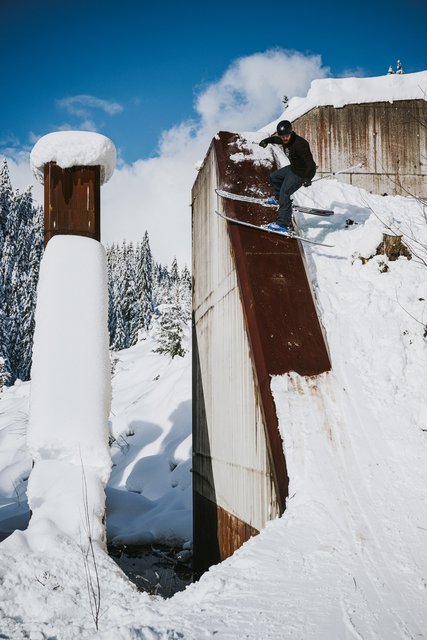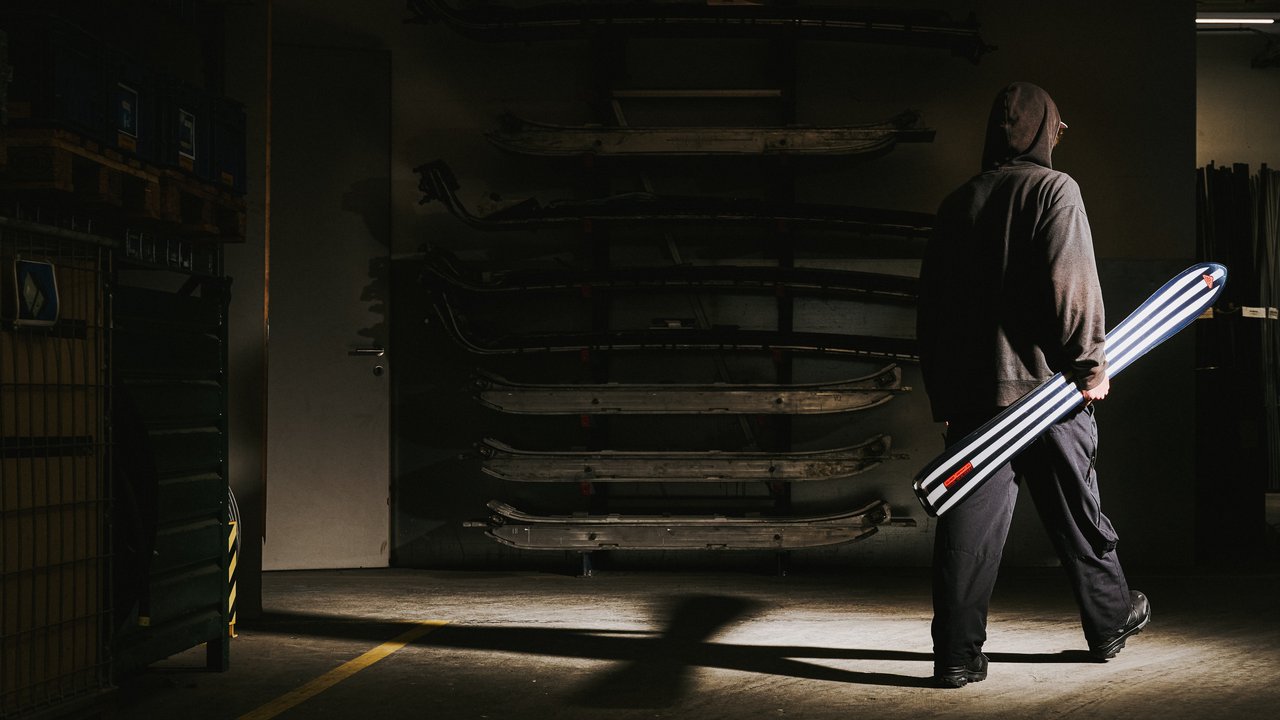Salomon is back in (post-?)freeskiing. That in itself is huge news. But the ski that launches today has to be easily the most teased, longest-developed that I can remember. I've been seeing Nico Vugnier around Switzerland on versions of this ski for what has to be at least five years. But it was in the last couple of seasons that the project kicked up a gear, and Sämi Ortlieb has been behind a lot of it. There's been a solid team in Europe for more than a year now, but until today, no product. Right now, the Depart .01 ski is launching at a small party in Innsbruck, Austria, but I've been skiing it a bunch over the past month and you can read the Roofbox Review here. It's a nice full circle that the first ski I ever owned was the TenEighty and Sämi was the first person I ever interviewed for NS. I wanted to check in with him to reveal more about this new Depart(ment) over at Salomon and what it all means.
_
Photos: Ruedi Flück
Nico, I've seen you around on some sort of jibby Salomon ski for several years now. When did this new Salomon project actually get started?
Around 2017, the 20th anniversary of the 1080 was coming up and I suggested starting something new at Salomon. We made some prototypes with 1080 graphics, that I skied for a while but that project didn't materialize. Then we were supposed to start working on this new idea in 2020, but COVID hit.
In 2022 we finally got back to working on the Depart project. A change in the management revived the project internally and the focus shifted to try creating something a bit more meaningful and innovative, rather than simply rehashing past successes. The 1080 graphic would likely have been a commercial hit, but the goal was to first build a structure, and team that makes will make sense in the long run. And not just bring back a random ski in Salomon’s line up.
_
Sämi, how did you get involved in the project and what's your role at Salomon now?
I was recruited by Nico. He was looking for someone who could work on videos for the project and just generally someone who has creative input.
I was really excited about the project because of Salomon's legacy in freeskiing combined with my personal history with the brand. From the 1080 being my first twin-tip ski to skiing for Salomon outerwear for a lot of years.
My role now is wider than what I expected when I got on. I joined as a skier and filmmaker, but now I do a bit of everything: developing skis, and other products ;), working on graphics, recruiting new team members, working on videos, and also very generally developing the future of the project.

_
So tell me about Depart, it has its own 'gram', is it a new 'brand'? Where do you see it going in the coming years?
Nico: It’s sort of a brand within the brand. I must admit, I was dreaming about one day being able to do something like Uninc. at Burton back in the day. But mostly importantly, considering the history of Salomon freeski and its evolution since the 2010’s we simply can’t go back and act like its 2008 and nothing changed. Salomon freeski now has a much broader audience than in its pure freestyle/freeride days of the past. I think it would be hard to convey the identity of our project if we were communicating through Salomon freeski’s channel, because the audience is just not the same. So having a clean break and starting from scratch was better than inheriting a huge audience / past image etc. Also that allows us to avoid chasing the algorithm on platforms like IG, having to create content for that. we just want to build something meaningful, take our time, support the riders with a common vision, and grow from there.
Sami: I think what is important to know is that the Depart01 is not a one-off ski. The project includes a whole line of skis that are all developed to serve different purposes for newschool freeskiing. The goal of the project is to create a segment within freeskiing that is not necessarily focused on technical tricks or big spins, but instead focused on flow, creativity, style, and self-expression. We try to show a relatable alternative of freeskiing that invites participation and we want to build the right skis for that.
_
I've skied the new ski but also tried a few laps on a couple of different versions, how many iterations of this ski have there been before this one?
I skied 3 different iterations of the first ski, which had more of a traditional twin-tip shape before we started working on the ski you see now. Nico skied more before that. The final ski looks pretty different from the previous ones but also encompasses a lot of things we learned from those first versions. On the final ski, we are also on the third version now.
It was such a special experience to see how committed Salomon has been to making our vision become reality. They put so much trust and resources in us and it was really important to them, to not just make new freestyle skis for the sake of making new freestyle skis, but to make it in the right way.

_
Sami, you told me a story about persuading the guys at Salomon HQ to include the pointy tip. Why did you guys want to include it and what was the issue with it?
There are so many aspects to the pointy nose shape (or this ski shape in general), that this answer could get infinitely long haha... so I'll just focus on 2 major points: Performance and concept.
The pointy tip just performs really well in fresh and soft snow. In powder, the tip breaks through the snow surface pretty quickly which gets the skis to float quicker. In general, the pointy nose cuts different snow surfaces, like wind crust or deep slush, in a very unique way. Overall the tip gives the ski quite a surfy performance. Another great thing about the nose is that it provides a pretty wide platform for butters, and again in soft snow, the pointy tip almost acts like a rudder and gives you more control during the butter.
Besides the performative advantages, the pointy tip also had conceptual ideas behind it. Very generally I wanted to build a shape that makes me want to go skiing and even though a pointier tip is a pretty illustrative way to do that, it worked for me at least. (It's just a really nice feeling, being on your skis and when you look down, the ski tells you to go haha). The overall aesthetic of the shape was heavily inspired by my own experiences as well as periods in skiing that influenced me. So basically it's a blend between 1930's wood skis, late 1990's freestyle skis, and bits and pieces of what I've picked up with my own experience of riding freestyle skis for the past 20 years.
Another important aspect for me was to create a shape that people would connect to a certain type of skiing and mindset. A shape that people can identify themselves with. Today freeskiing has such a wide spectrum that ranges from highly professionalized and athletic comp skiers with teams and coaches to fully independent groups of skiers who focus for example on street skiing. Sometimes it feels like there are different sports within freeskiing. It feels like traditional twin-tip shapes relate and identifies more with the athletic and technical side of skiing. So I wanted to create a ski with a new shape and a bit of a different performance than traditional twin tips. A ski with a performance that supports the type of skiing we want to do while giving a strong visual identity. For example: if you ski those kinds of skis and you see another person on the hill with those kinds of skis, you know you'll be friends if that makes any sense. Kinda like how it was back when freeskiing started, you could chat to anyone with twin tips, it was kinda of a unique thing...

_
Who is on the team and how did you pick the squad?
Team: Vilma Warpenius, Nico Vuignier, Dane Kirk, Skye Clarke, Sleepy Grill, Benjamin, Gavin Rudy, Pontus Pentila, and myself.
Sami: The team is basically a group of people who represent the kind of skiing I enjoy watching. I feel like everybody on the team has a unique vision for skiing, that is more based on flow and self-expression, and less focused on getting super technical. Also, I think we have skiers on the team who are just absolutely incredible but haven't necessarily had the platform to show what they do yet. So I hope this project can become a platform.
Nico: A part of the vision was to include skiers with diverse personalities and creative outlets, It's not just about their performance on the slopes; it's about embracing a broader perspective of our sport and the ski culture at large. I wanted to have riders who ski things and terrain that are accessible to anyone without needing to be part of a national team or own an expensive sled.


Comments